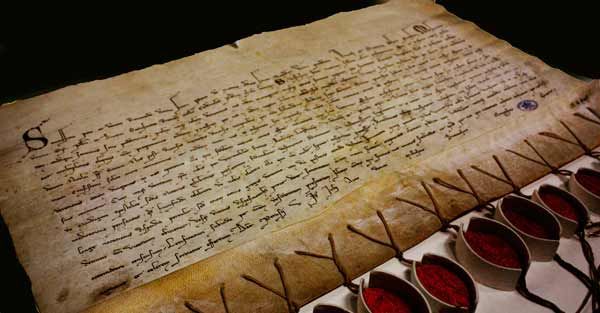From the court records of the trial of Galileo Galilei, to the request for annulment of the marriage of Henry VIII to Catherine of Aragon, the Vatican archives house innumerable documentary treasures. And if you're visiting Rome this year, you have until September to visit the Lux in arcana exhibition at the Musei Capitolini – the Capitoline Museums – in Piazza del Campidoglio, where a hundred of these precious writings are on display to the public for the first – and possibly the only – time outside the confines of the Vatican City.
Set on one of the seven hills of Rome, the Capitoline Museums are housed in three palazzi – previously the papal seat of government – arranged around a courtyard with a larger-than-lifesize statue of the emperor-philosopher Marcus Aurelius at the centre. (The statue is a replica, but the original can be seen in one of the museums.)
Subtitled The Vatican secret archive reveals itself, the exhibition celebrates the fourth centenary of the Vatican Secret Archives – founded in 1612 by Pope Paul V – where over 15,000 documents dating from the eighth to the twentieth century are now held on 85 kilometres of shelving. The Latin title of the exhibition, Lux in arcana, conveys the main objective of the display: to shed light on the innermost mysteries of the archives.
Among the scrolls, parchments, manuscripts, and writings of the last twelve centuries that are on display, is the Inter Cetera papal bull of Pope Alexander VI; dated 1493, just after Columbus' arrival in the Americas, the document sets out the boundaries between Spanish and Portuguese findings in the New World. There are two extant copies of this bull, the one on display in Rome and the original, held in the Archivo de Indias in Seville, Spain.
At the exhibition, you'll also be able to discover the proceedings of Galileo's trial, from the original summons to appear before Bellarmino in 1616 through to the guilty verdict in 1633 when he was ordered to recant his opinions. On display, too, is the letter sent in 1530 by the members of the English Parliament to Pope Clement VII urging a swift ruling on the matter of the annulment of Henry VIII's marriage to Catherine of Aragon. This parchment carries the signature of 83 parliamentarians and Henry's most trusted advisers, including Thomas Wolsey, Papal Legate to the English court, who, despite signing, was executed for treason that same year.
There's a letter from Pope Clement VIII written to the Incas in the Quechua language, and another sent by Pierre Pilsemont, chief of the Ojibwa tribe, to Pope Leo XIII thanking him for sending a “guardian of prayer” to his tribe; written on birch bark, the address of the letter is "There where the Great Grasses are" and it is dated "in the month of the flowers".
The summary of the trial of Dominican friar Giordano Bruno, condemned to death by the Inquisition and burned at the stake in Rome in 1600 is on display, too, along with a parchment almost 60 metres long containing the testimonies of 200 Knights Templar in fear for their lives after 54 of their order had been burned at the stake as relapsi – heretics who had recanted and then fallen once more.
The papal bull by which Leo X excommunicated Martin Luther, the founder of the Protestant Reformation, a note written in prison by Marie Antoinette before her execution, documents on the dogma of the Inmaculate Conception, a letter from the young visionary Bernadette to Pope Pius IX, a letter from Lucretia Borgia to her father, the Spanish Pope Alexander VI, a letter from priests imprisoned in the Nazi death camp of Dachau... the vast range of writings from an incredible cast of characters are collected in this tiny fragment of the secret archives and show without a doubt the extent to which the history enshrined in the Vatican archives entwines with the history not just of the Catholic church, but of the world as a whole.Learn more: Lux in arcana











